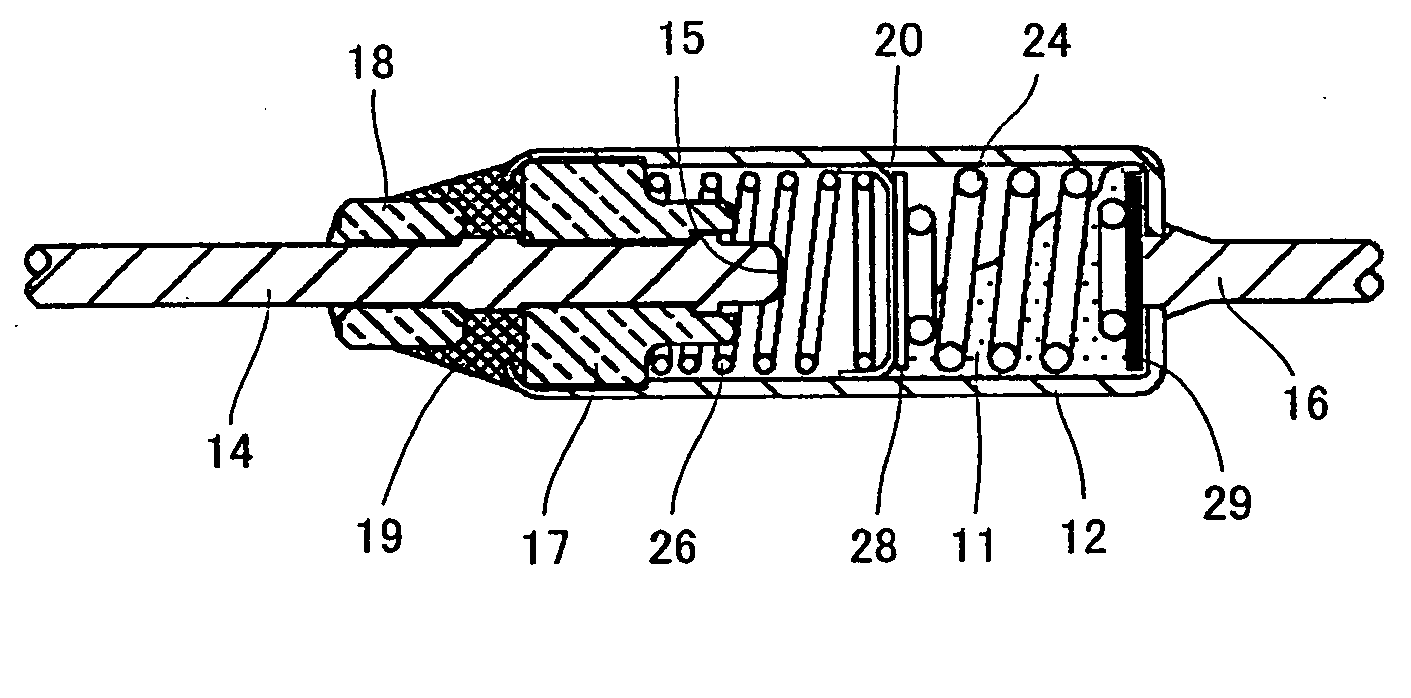Thermal fuse employing thermosensitive pellet
a thermosensitive pellet and fuse technology, applied in the direction of thermally actuated switches, electric switches, electrical apparatus, etc., can solve the problems of affecting the operation, the thermosensitive pellet is not thermally sufficiently stable, and the material softens, deforms, and sublimates more disadvantageously than the material, so as to achieve reliable and rapid operation, reduce the effect of material was
- Summary
- Abstract
- Description
- Claims
- Application Information
AI Technical Summary
Benefits of technology
Problems solved by technology
Method used
Image
Examples
first example
[0029]FIGS. 1 and 2 are cross sections of the present thermal fuse employing a thermosensitive pellet before and after operation, respectively. As will be described hereinafter, the present thermosensitive pellet can be processed by a variety of methods to facilitate activation. For the sake of illustration, the present invention employs polyolefin implemented by high density polyethylene HDPE (melting point: 135° C.) and low density polyethylene LDPE (melting point: 110° C.) for a total of two types of resin materials mixed together to produce a thermosensitive pellet 10 processed to facilitate activation. In the present example, as shown in FIG. 1, HDPE or a first resin member and LDPE or a second resin member mixed therewith provide thermoplastic resin, which forms thermosensitive pellet 10 housed in a cylindrical, metallic casing 12 as a component of a member that functions to switch an electrical circuit path.
[0030]Metallic casing 12 has one end opening with a first lead member...
second example
[0034]FIGS. 5A-5G are perspective views of exemplary variations of the thermosensitive pellet employed in the thermal fuse. The shown seven types of exemplary variations all effectively provide faster response for switching. FIG. 5A shows a thermosensitive pellet formed of different types of resin materials mixed together and pelletized, and corresponds to thermosensitive pellet 10 described in the first example and formed of the first and second resin materials mixed together. More specifically, the process that facilitates activation is to mix resin materials, and it forms or produces a cylindrical pellet 100 of different resins mixed together. The pellet has a diameter approximately equal to an inner diameter of the casing.
[0035]FIGS. 5B-5E show four types of exemplary variations each having a portion cavitated (i.e. provided with at least one cavity) and thus reduced in unit weight. The FIG. 5B pellet is a thermosensitive pellet provided with bubbles 101 and thus cavitated to pr...
third example
[0037]Hereinafter will be described a thermosensitive pellet that is processed to facilitate activation by cavitating and thus reducing the pellet in weight. More specifically, the pellet can be cavitated (i.e. provided with at least one cavity) to be reduced in unit weight to provide increased response speed in switching. As an index, a degree of reduction in weight is represented by the volume percentage of any cavities relative to the total volume of the pellet, or degree of cavitation (vol %). Cavitation, response speed and operating temperature as measured are indicated in Table 2. Furthermore, cavitation, response speed and operating temperature have a relationship as shown in FIG. 3. In the present example, thermosensitive pellets with different cavitation were prepared as samples and each sample was immersed in an oil bath and thus increased in temperature, and an operating temperature causing thermal deformation and a period of time required for a prescribed amount of defor...
PUM
 Login to View More
Login to View More Abstract
Description
Claims
Application Information
 Login to View More
Login to View More - R&D
- Intellectual Property
- Life Sciences
- Materials
- Tech Scout
- Unparalleled Data Quality
- Higher Quality Content
- 60% Fewer Hallucinations
Browse by: Latest US Patents, China's latest patents, Technical Efficacy Thesaurus, Application Domain, Technology Topic, Popular Technical Reports.
© 2025 PatSnap. All rights reserved.Legal|Privacy policy|Modern Slavery Act Transparency Statement|Sitemap|About US| Contact US: help@patsnap.com



